Exactly How to Spend One Week in Sicily (for First Timers)
If you are looking for a perfect blend of history, culture, and natural beauty, then Sicily is the place to go. Alysha’s family immigrated to the United States from Sicily a couple of generations ago (Matt’s too, actually, though he looks far less Sicilian), so Sicily has a special place in her heart.
The largest island in the Mediterranean Sea, Sicily is a treasure trove of ancient ruins, historic architecture, and picturesque scenery. Its diverse geography ranges from pristine sandy beaches to a towering volcano looming over the eastern half of the island.
Sicily also has a different cultural identity from mainland Italy due to the many different civilizations that occupied it at various times throughout its history. This has resulted in the island being covered in ancient ruins that are stacked upon each other; Roman on top of Greek on top of Phoenician.
As we planned our three month European extravaganza after we quit our jobs to bet it all on this travel site (which happened in February 2020 – OOPS!), Sicily was the first thing we penciled in.
We spent three weeks exploring the island a couple of years ago, making a big loop around the perimeter of the island, and we fell in love with the beaches, the history, and the cuisine – specifically granita and pasta alla norma.
Unfortunately, we don’t really think that 7 days is enough time to explore the entire island (Sicily is BIG).
We spent over three weeks on our own Sicily adventure and it was still difficult to squeeze in everything that we wanted to.
But one week is long enough to dive deep into one area of the island. And we’d recommend starting with the east coast.
The east coast of Sicily is a stunning stretch of coastline that boasts crystal clear waters, sandy beaches, and rugged cliffs.
From the charming town of Taormina, nestled in the shadow of Mount Etna, to the historic city of Siracusa, there is no shortage of beautiful spots to explore, and there is plenty to do and see to fill an entire week.
In this guide, we’ll take you through our thinking on how to spend one week in Sicily, focusing on the island’s south/southeast coast and highlighting the best places to visit, foods to try, and experiences to be had.
We’ll also cover important logistics – like getting between places, where to stay, how to structure your itinerary, and more.
Sound good to you? Let’s get into it.
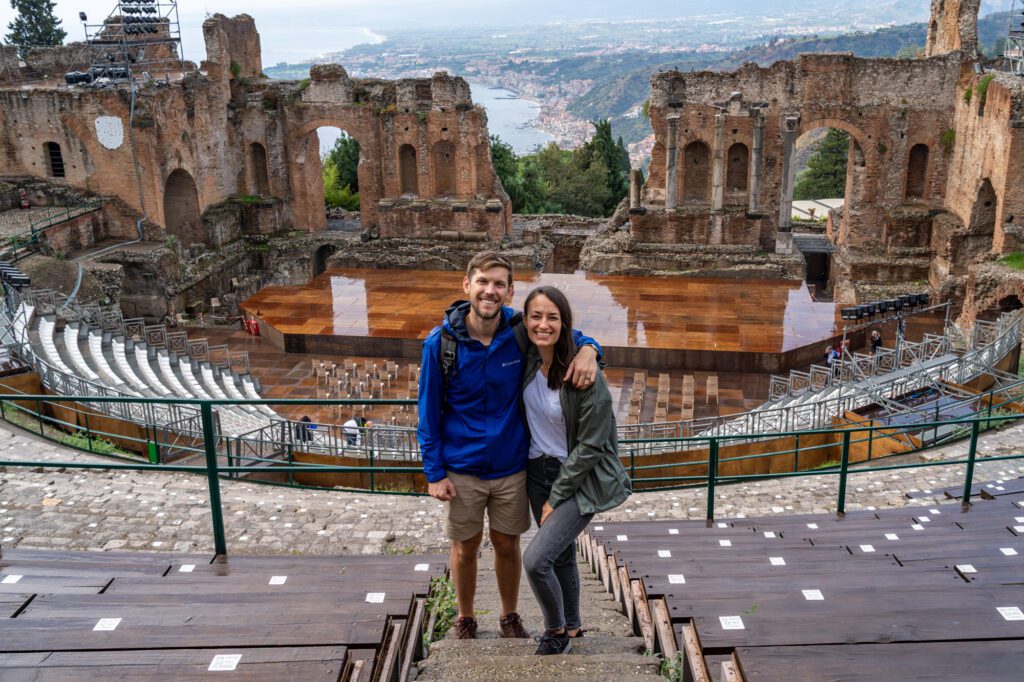
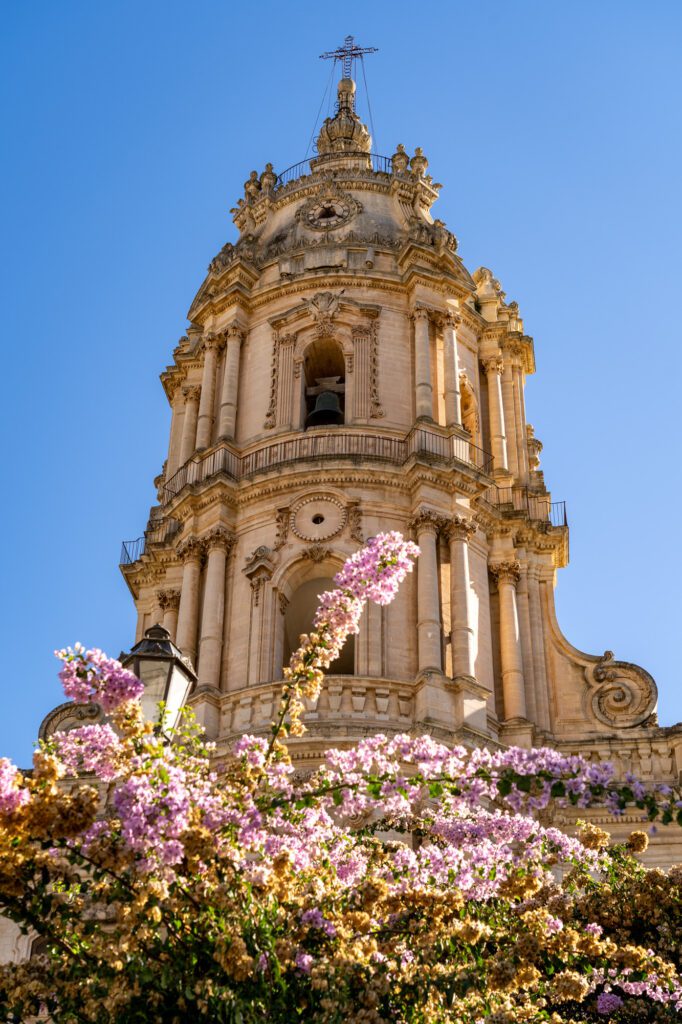
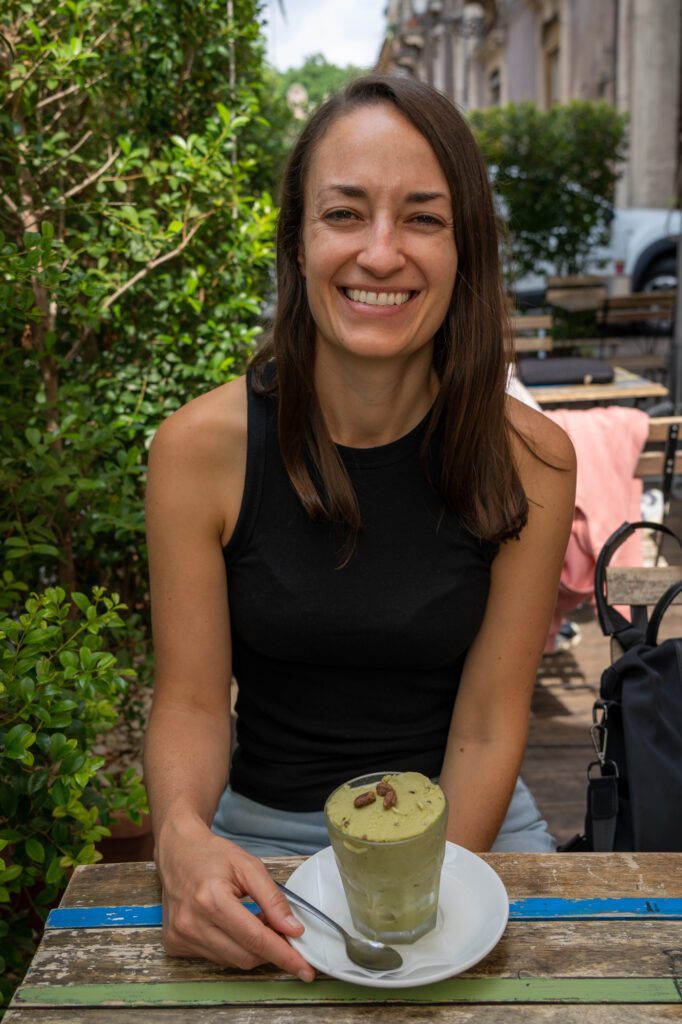
Disclaimer: Some of the links below are affiliate links, which means that if you click on one and purchase something, I make a small portion of the sale at no additional cost to you. It goes without saying that I would never recommend something I wouldn’t use or do myself.
What Can You See with 7 Days?
To reiterate the above, our main piece of advice is not to try to see every single corner of the island in 7 days.
It’s just too big.
We had three full weeks, and still found ourselves driving long distances and saying “guess we’ll need to come back for that.”
With 7 days in Sicily, we think you should focus your time on exploring EITHER the eastern or western coast.
If it’s your first time on the island, we’d recommend heading to southeastern Sicily and checking out Taormina, Catania, Siracusa and Ortigia, and the Val di Noto.
Not only is southeast Sicily our favorite part of the island, but it’s also largely accessible via public transportation. This means that it’s doable if you want to avoid renting a car in Sicily (more on that in a second).
Have more than one week? Check out our two week Sicily itinerary here, which includes the highlights of both eastern and Western Sicily (including Palermo!).
How to Get Around Sicily (and Do You Need a Rental Car?)
For the most part, you’re going to need to rent a car to really explore Sicily. The island isn’t quite as well connected by public transportation as other regions of Italy.
However, the southeastern corner of the island – the part we’re focusing on in this itinerary – is actually fairly well connected by a regional train line. It’s often slower than driving, but it will get you between the bigger cities and towns like Taormina, Catania, and Siracusa.
Combine the train with a couple of tours, and you can get good coverage on this slice of Sicily without needing to rent a car.
If you do want to get a little further afield, like Ragusa, the beaches of Riserva Vendicari, and Marzamemi, then you will want to rent a car.
We’d suggest renting it as you leave Siracusa to head to the Val di Noto. This way, you don’t have to deal with parking in the bigger cities and towns.
Plus, you don’t really need a car up until that point anyway – on our trip, we were carless until we left Siracusa.
Where to Start and End Your Trip?
The below 7 day Sicily itinerary will focus on the southeastern corner of the island, so you can fly in and out of Catania.
Catania–Fontanarossa Airport (CTA) is the second-largest international airport in Sicily (Palermo is the biggest) and the largest on the island’s east coast.
The airport serves numerous European carriers. When flying from the US, you’ll need to transfer via another major European city, such as London, Amsterdam, or Paris first.
You can reach Catania’s city center from the airport in roughly 20 minutes using the AMT Alibus shuttle bus.
7 Days in Sicily: A Perfect Itinerary for First Timers
For the sake of the itinerary below, we’re assuming that you’re arriving on the island the evening before and leaving on the final evening/the morning after, giving you a full 7 days to explore.
Here’s what that looks like:
- Day 1: Catania
- Day 2: Day Trip to Taormina (stay in Catania)
- Day 3: Day Trip to Mount Etna (stay in Catania)
- Day 4: Siracusa & Ortigia
- Day 5: Siracusa & Ortigia
- Day 6: The Val di Noto
- Day 7: The Val di Noto
We’d suggest spending your first three nights in Catania, using it as a home base for day trips to Taormina and Mount Etna, rather than trying to move around every day (which is both more tedious and less flexible).
Day 1: Explore Catania
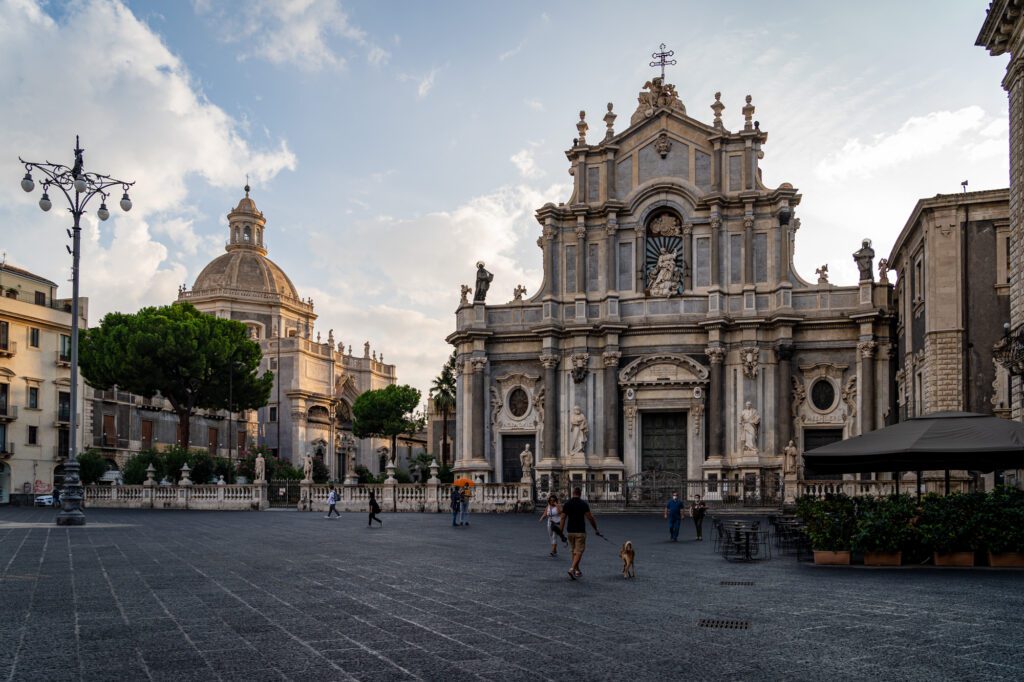
Nestled at the foot of mighty Mount Etna, Catania is a charming port city that offers a unique blend of history, culture, and delicious food that make it a perfect introduction to Sicily.
Its central location on the island’s east coast also makes it the perfect place to start and end this 7 day Sicily itinerary.
Catania has a rich and fascinating history that dates back to the 8th Century BC when it was founded by the Greeks.
Over the centuries, the city has been ruled by various powers such as the Romans, Byzantines, Arabs, Normans, and Spanish, each leaving their mark on the city’s architecture, culture, and cuisine.
During the 17th Century, Catania was hit by a devastating earthquake AND a large eruption of Mount Etna, while allied bombing during WWII also caused significant damage to the city.
But each time, Catania was rebuilt and has since become a thriving cultural and economic center and a popular tourist destination.
We liked Catania, and think a day is about the right amount of time to spend exploring the city itself, with a couple of day trips to fill the other days.
Things to Do in Catania
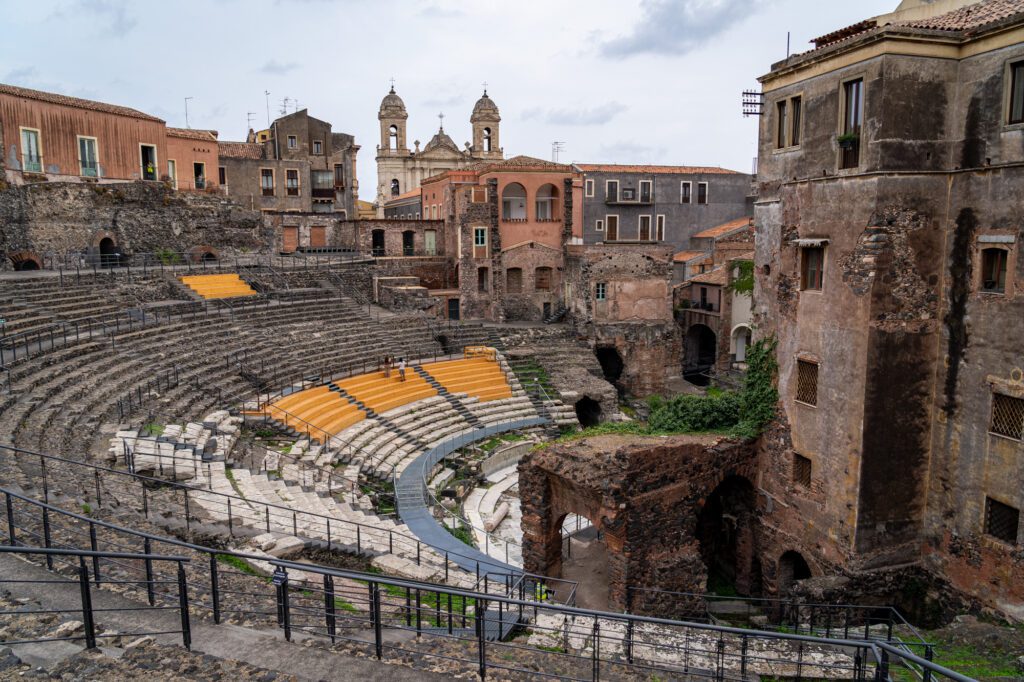
Some people choose to only use Catania as a base for exploring other nearby destinations (which you’ll be doing on days 2 and 3 too).
But we think the city is worth spending some time exploring in its own right. One day in Catania is enough to see the city’s main highlights.
The thing about Catania is that, because there are so many groups of people that have called it home, it’s essentially a city, built atop a city, built atop another city.
It has layers – like an ogre – that make it a fascinating piece of history, and that phenomenon of cities (or temples) built atop old versions is a theme you’ll see all across Sicily.
Below are some of our favorite things to do in Catania.
Experience the Fish Market
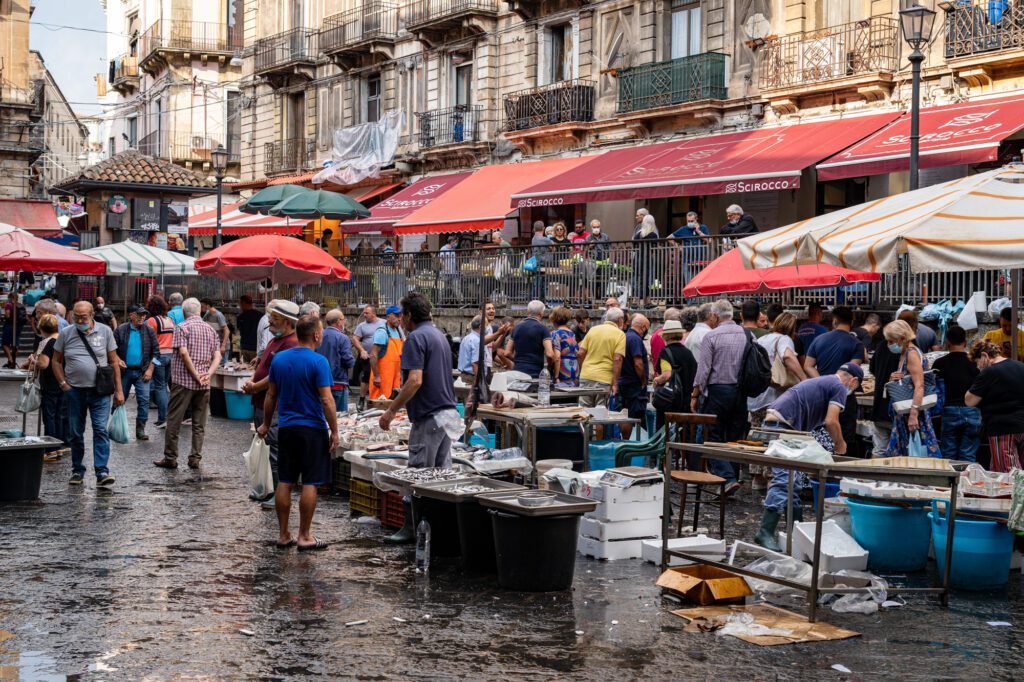
Sicily is an island known for its abundance of fresh fish and seafood. And there’s no place quite like Catania’s vibrant fish market to see this for yourself.
Plus, it’s not just fish – there are plenty of local vendors selling meat, cheese, fruits, vegetables, and nuts too.
Head to the market in the early morning to see it at its liveliest, with energetic locals haggling for the best catch of the day. It’s open every day of the week except Sunday.
Take a tour of the Benedictine Monastery
Monastero dei Benedettini di San Nicolò l’Arena was one of the largest and most beautiful baroque Benedictine Monasteries in all of Europe.
The building is also a great example of how Catania adapted to the lava flows from the 1669 eruption of Mount Etna.
You can only visit the building’s interiors on a 75 minute guided tour, which offers a great introduction to the history of the building and Catania as a whole.
Marvel at the Teatro Antico Greco-Romano di Catania

Catania’s Ancient Roman theater is another of the best examples of how the city has been built up in layers due to volcanic eruptions in the region. Modern 19th Century buildings tower over the excavated 2nd Century Roman theater, which in turn was built on top of an existing Greek building dating back to 300 BC.
Eat your first granita!
Granita is a Sicilian specialty, which is like ice cream without the cream. Perfect for cooling you down on a hot day in Catania.

You can find granita at pretty much every cafe and pasticceria across the island, but we particularly loved Caffetteria Villaroel (here on Google Maps).
Granita comes in local flavors such as pistachio, almond, coffee, and seasonal fruits. Our favorite is pistachio – anything pistachio is the right call in Sicily.
Museo Storico dello Sbarco in Sicilia 1943
This is a great museum dedicated to Sicily’s role in World War 2, which was eye-opening for us as Americans who always think of WWII affecting mostly mainland Europe.
It’s a fascinating museum that’s certainly worth an hour or two of your time, even though there are some parts of the signage that aren’t translated into English.
Our favorite part of the museum was a temporary photography exhibition that featured photos taken during the war by military photographers.
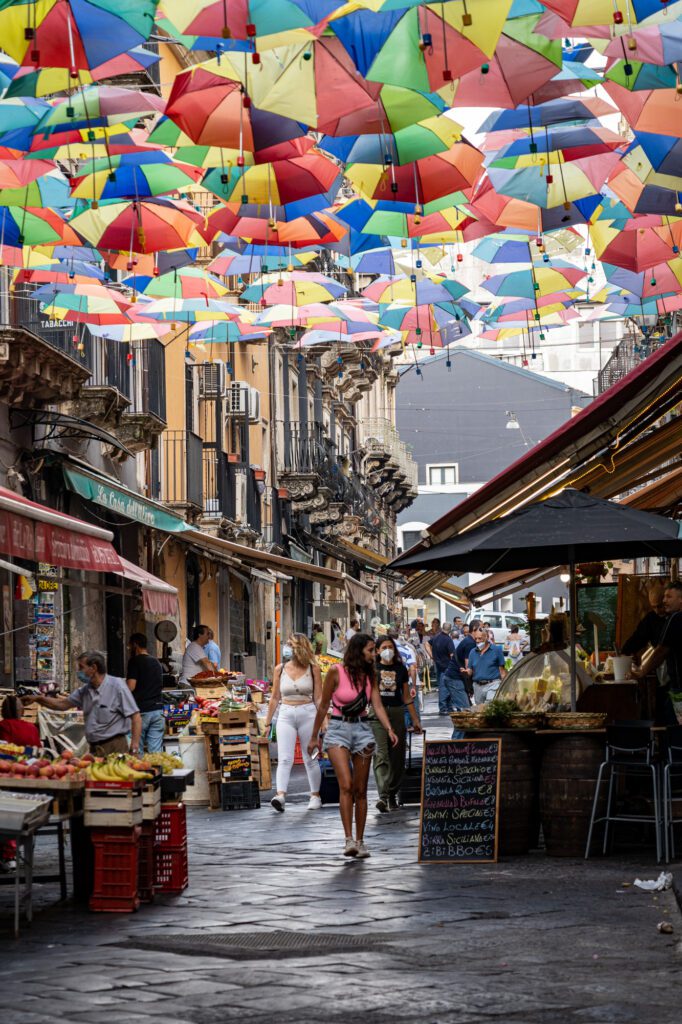

Where to Stay in Catania
As we mentioned above, we’d suggest staying in Catania for your first three nights and doing day trips from here. Catania is a great base for exploring other towns and attractions in the region.
In Catania, try to stay near Piazza del Duomo, and avoid going more than two or three blocks east or west of Via Etnea.
Staying in this area puts you smack dab in the middle of basically everything you’re going to want to see in Catania. It’s also within walking distance of the train and bus station, which is useful for getting to Taormina and Mount Etna.
We stayed in one of Duomo Housing Catania’s beautiful apartments, located just off of Piazza del Duomo and right over the fish market.
It was a phenomenal location in terms of centrality and walkability, but probably not the best place to stay for light sleepers or late risers due to the noise of the fish market setting up early each morning.
Other Options in Catania:
- Urban Pop 2 BnB – a cute and quirky pop-art-themed bed and breakfast with affordable private rooms and shared dorm rooms.
- Palazzo Scammacca – simple, elegant, and spacious private apartments, some of which feature fully equipped kitchens and private terraces.
- Habitat – a stunning, super stylish boutique hotel just a few blocks west of Via Etnea.
Day 2: Day Trip to Taormina
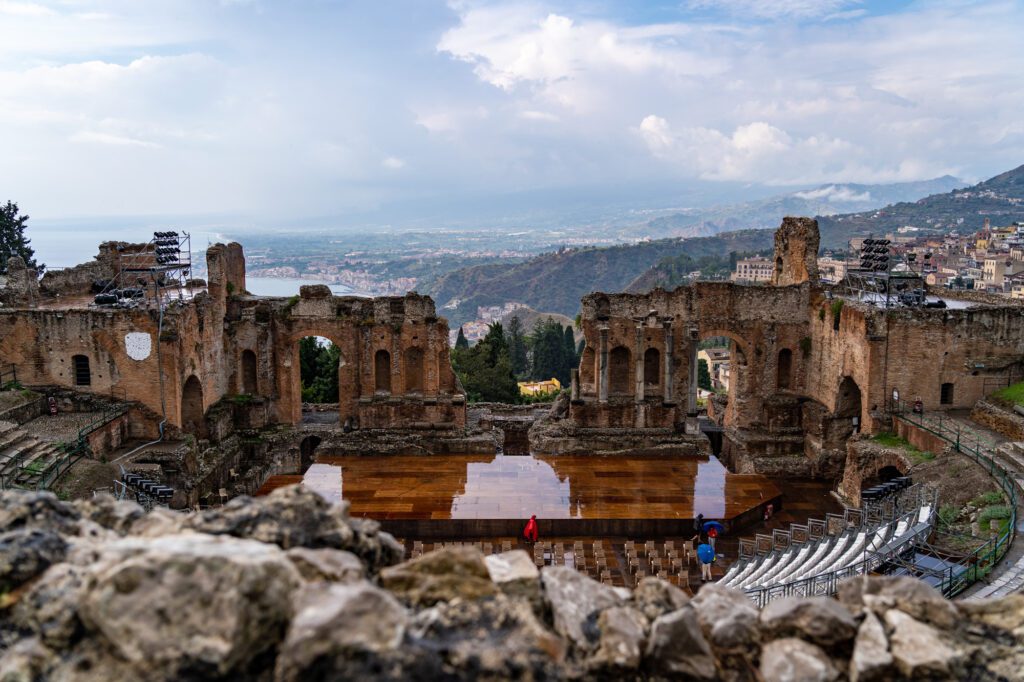
On your second day in Sicily, take a day trip from Catania to the charming seaside town of Taormina.
Located on a hilltop overlooking the Ionian Sea and Sicilian coastline, the historic coastal town is best known for its ancient Greco-Roman theater and unique beach.
The town is particularly popular among day-trippers, so try to arrive early in the morning to avoid the worst of the crowds.
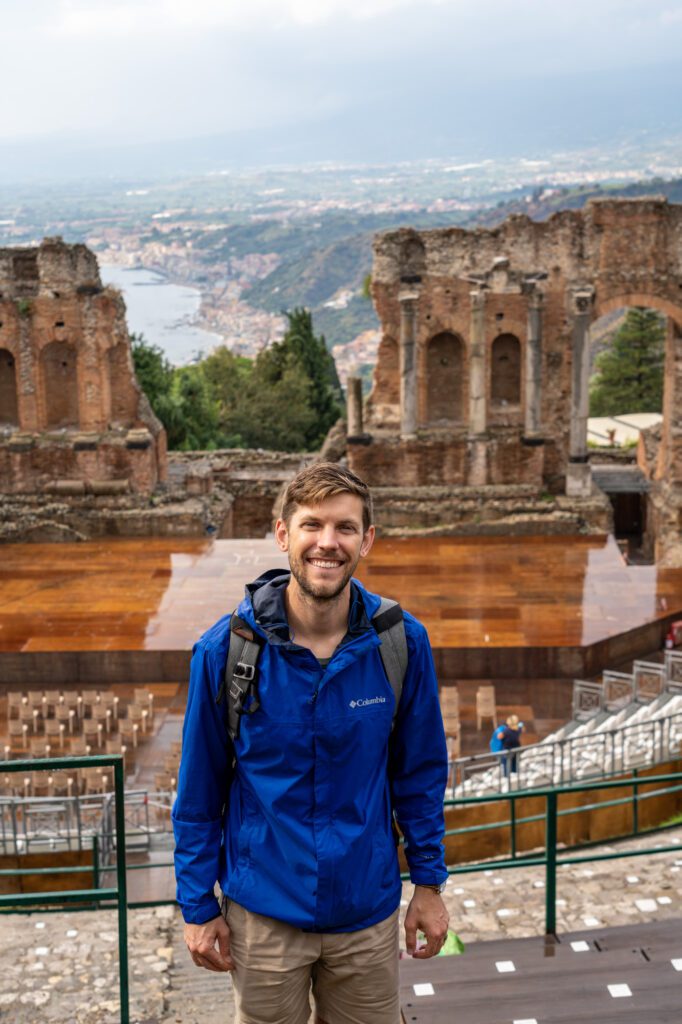

Getting To Taormina
The best way to get from Catania to Taormina without a car is by train.
The high-speed Intercity train can get you between the two cities in as little as 35 minutes, while the Regional train takes anywhere between 50 minutes and 1 hr 10 minutes.
Tickets for both start at around 5.50 Euros each way, depending on when you book. There’s not a huge difference in ticket price, so try to catch one of the Intercity trains if possible to give you more time in Taormina.
It’s important to note that the train drops you off at the very bottom of town, and the main part of town is perched on a hill above the water.
We walked up to the town center and it took around 15-20 minutes (here’s the route). You can also take the bus (Interbus) up to town for 1.90 Euros, or catch a taxi instead.
Things to Do in Taormina
From exploring ancient ruins to hiking scenic trails and sampling the area’s delicious cuisine, there’s something for everyone in Taormina.
Take in The Teatro Antico di Taormina

Taormina’s spectacular Greco-Roman amphitheater dates back to the 3rd Century BC and has been used for various purposes throughout history, including gladiator battles and concerts.
Today, it’s a popular tourist attraction and is still used for performances and events during the summer months – so check if anything is happening during your visit.
The theater is perched on a hilltop and offers stunning views of the surrounding landscape, including neighboring Mount Etna and the Ionian Sea.
Hike up to Chiesa Madonna della Rocca
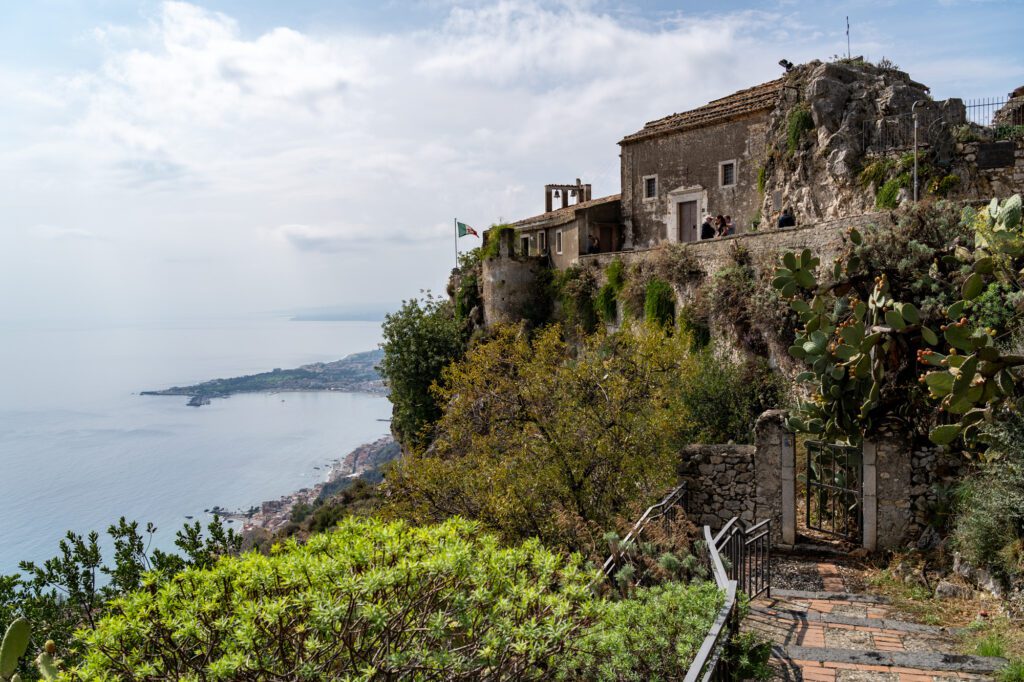
This historic hilltop chapel (here on Google Maps) is not only a beautiful example of Sicilian Baroque architecture, but it also offers amazing views over Taormina and the bay below.
The trail leading to the church is steep and a little challenging, but it’s more than worth the effort for the views along the way.
If the hike is too much, consider taking a taxi to the top then walking back down.
Once at the top, stop for lunch on the beautiful terrace of Al Saraceno, located just a few steps away from the church.
Granita at Bam Bar
We stopped here for granita twice in the same day! The elegant cafe-bar is famous for its granita, with rotating flavors posted on the board outside each day.

They also serve coffee, pastries, and aperitifs, and there’s a lovely terrace outside for a spot of people watching.
Stroll Along Corso Umberto.
Corso Umberto is Taormina’s lively pedestrianized main street which is full of shops, bars, and restaurants. The street is almost always packed with tourists, but it’s still worth a quick stroll.
Hit the beach!
If you’re visiting Taormina on a hot day, take a walk (or the cable car) down to Isola Bella, a small island that’s connected to the mainland via a narrow pebble beach. The unique beach is a lovely spot for sunbathing and paddling in the clear blue waters.
Day 3: Day Trip to Mount Etna
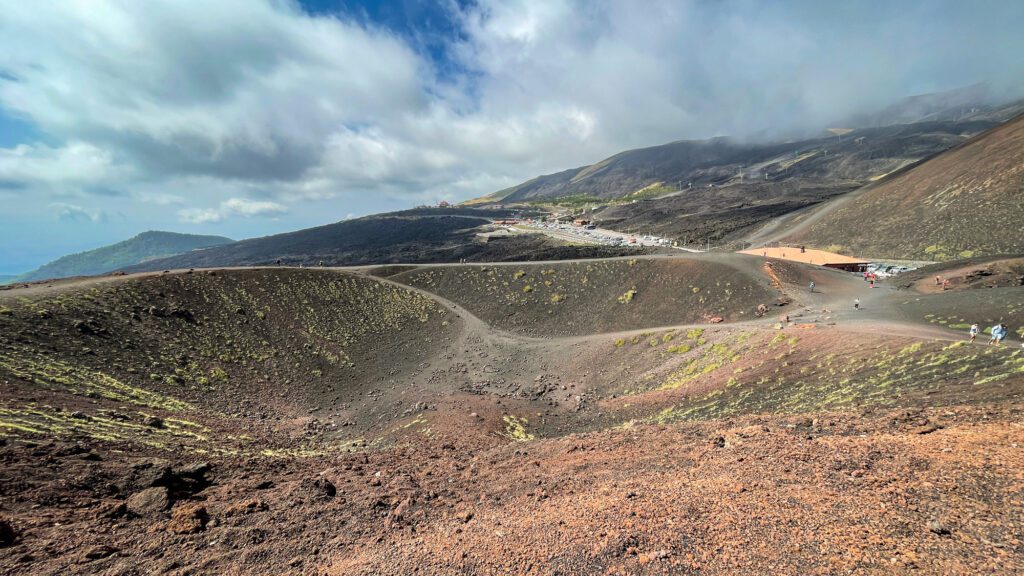
Mount Etna is the highest active volcano in Europe and one of the most active volcanoes on the planet. The regular volcanic activity has shaped much of eastern Sicily and is intrinsically linked to the history of the region.
Despite its frequent eruptions, Mount Etna is still considered safe to visit. In fact, hiking up to its summit to experience the breathtaking views of the surrounding landscape is one of the most popular things to do in all of eastern Sicily.
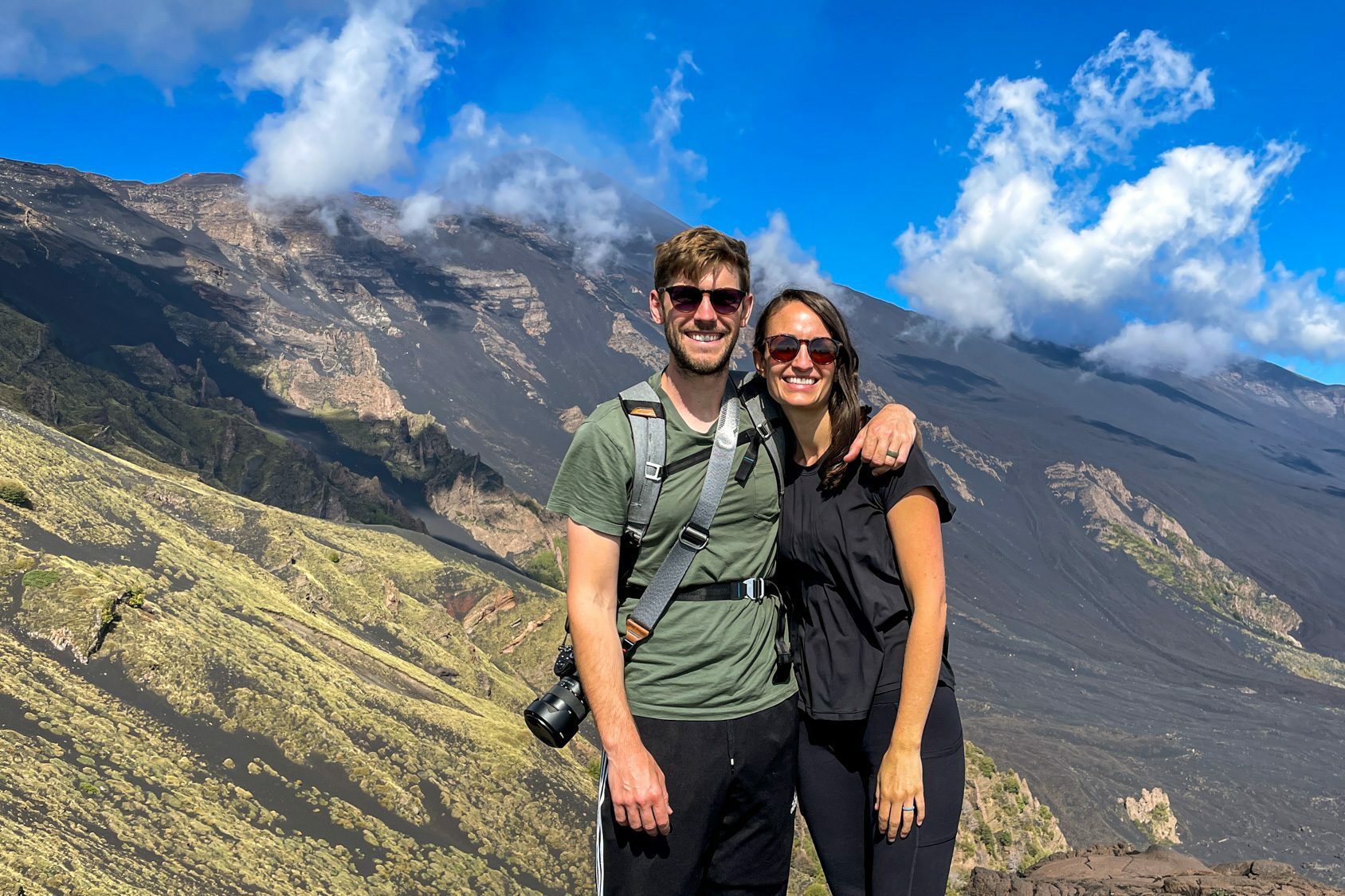
Getting To Mount Etna
Due to the logistics of getting to and from Etna – there’s basically one bus in each direction per day, and it’s a long ride (more info here) – we would recommend either renting a car for the day and driving yourself, or hopping on a guided tour.
Driving
Driving is the only way to get to Mount Etna in time to join a guided summit tour, which leaves around 9:00 am each morning (which is before the bus arrives).
You’ll need to drive from Catania to Rifugio Sapienza on the southern slope of Mount Etna to join the morning tours. The drive will take you around an hour.
If you don’t want to take an organized tour, you can still drive yourself to Rifugio Sapienza and head to the summit by yourself. From Rifugio Sapienza, you can catch the cable car (30 Euros return) up to a certain point, then hike the rest of the way up to the famous craters on your own.
Guided Day Trip
A guided day trip is the easiest way to visit Mount Etna without a car. There are plenty of different options to choose from – including tours that visit the typical tourist areas, and tours that go a little off the beaten path (we chose the second).
We did this tour with Marco, a Catania native, and would highly recommend it.
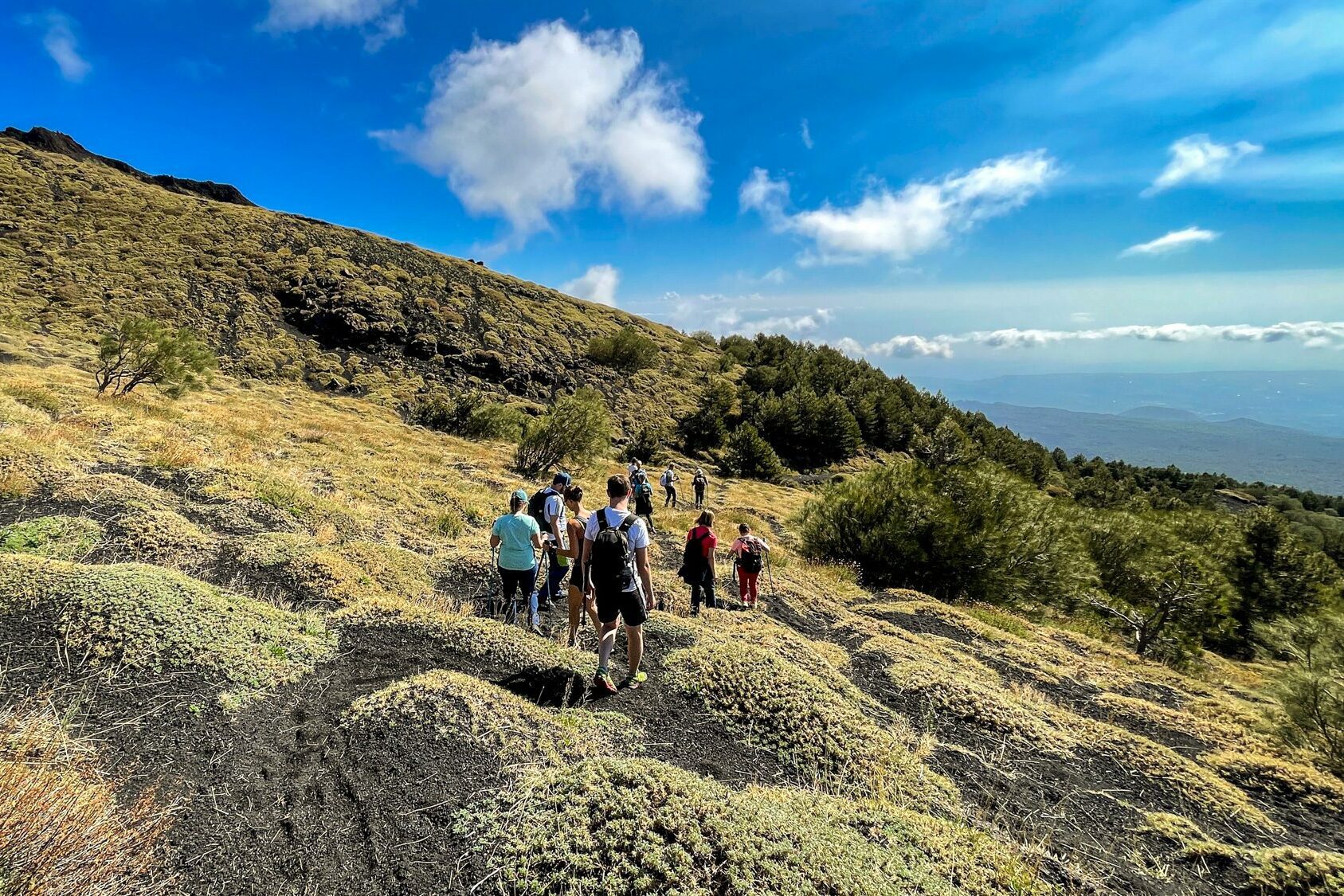
The tour first takes you on a hike to view Etna from a different angle than the one most tourists get. It then takes you up to the main area for a little bit of exploring. It also includes transportation to and from Catania.
If you’re not as excited about hiking, this sunset jeep tour is another great alternative.
Days 4 & 5: Siracusa and Ortigia
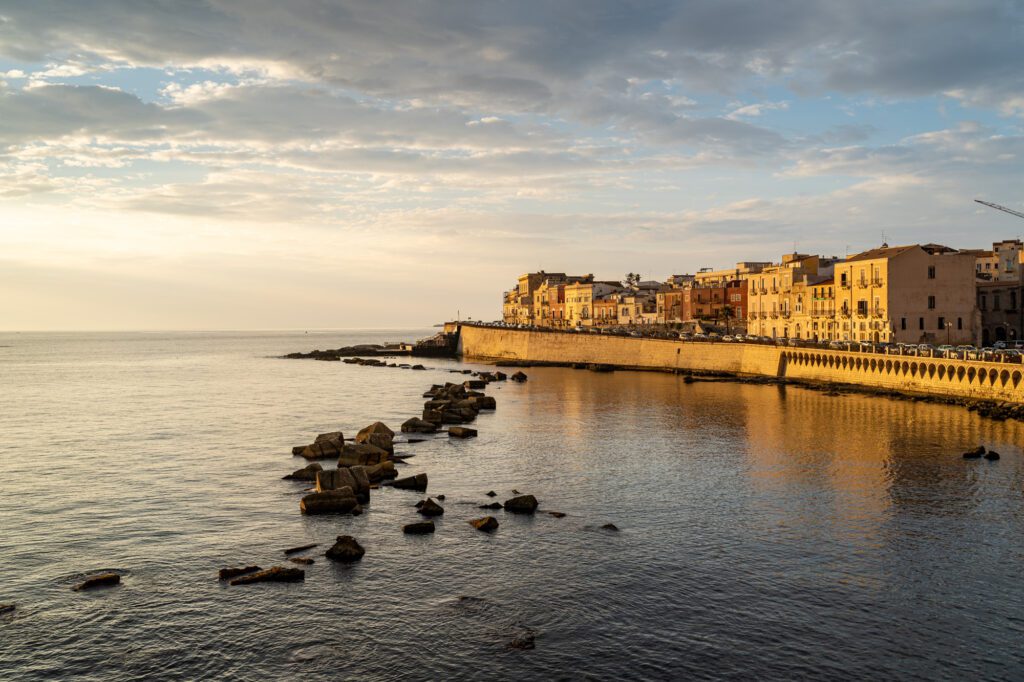
Let’s start with a quick geography lesson. There’s a common misconception that Siracusa and Ortigia are two different cities. But this isn’t exactly true.
Siracusa is the city on the mainland, while Ortigia is a small island that is home to the historical city center of Siracusa.
The two are connected by a series of bridges. You’ll hardly notice that you’re passing from one into the other.
Now for a little more about Siracusa. During its early history, the ancient city was one of the most important hubs in the Mediterranean, thanks to Sicily’s strategic position between Italy, Spain, Greece, and North Africa.
The city was founded by the Greeks, before becoming a part of the Roman Empire. It was even briefly the capital of the Byzantine Empire in the late 7th Century.
The city changed hands between the Aghlabids (Muslims from North Africa) and the Byzantines for several hundred years, before finally falling under Norman rule.
And all of these influences are apparent in the city you’ll see today, from the North African inspired cuisine (expect plenty of couscous) to the amazing Greek and Roman archeological ruins.
On a visit to the city, you’ll spend most of your time in Ortigia, which is famous for its charming cobblestone streets and stunning sea views. However, you’ll also want to take a journey out to the famous archeological park on mainland Siracusa.
Getting To Siracusa and Ortigia
Driving is the quickest way to travel between Catania and Siracusa, with the journey taking as little as an hour without traffic. However, we really don’t think you need a car.
Siracusa and Ortigia aren’t the most car-friendly destinations, so you’ll just end up leaving your car on the outskirts of town until you’re ready to leave again.
Instead, we’d suggest catching the direct train from Catania Centrale Station to Siracusa, which you can book through Trenitalia for around 8.40 Euros one way. The journey takes approx. 1 hr and 15 minutes.
It’s worth noting that the train station in Siracusa sits around a 20 minute walk from the historic center of Ortigia.
If you’d rather not walk with your luggage, you can always grab a taxi from the train station.
Another option is jumping on the bus from Piazza Borsellino in Catania (a short walk from Piazza del Duomo), which takes around 1 hr 20 minutes to arrive in Siracusa. You can book tickets in advance via Interbus.
The bus is slightly cheaper than the train, with tickets starting at 6.20 Euros one way.
Things to Do in Siracusa and Ortigia
Here are some of the best things to do in Syracuse and Ortigia.
The Parco Archeologico Neapolis
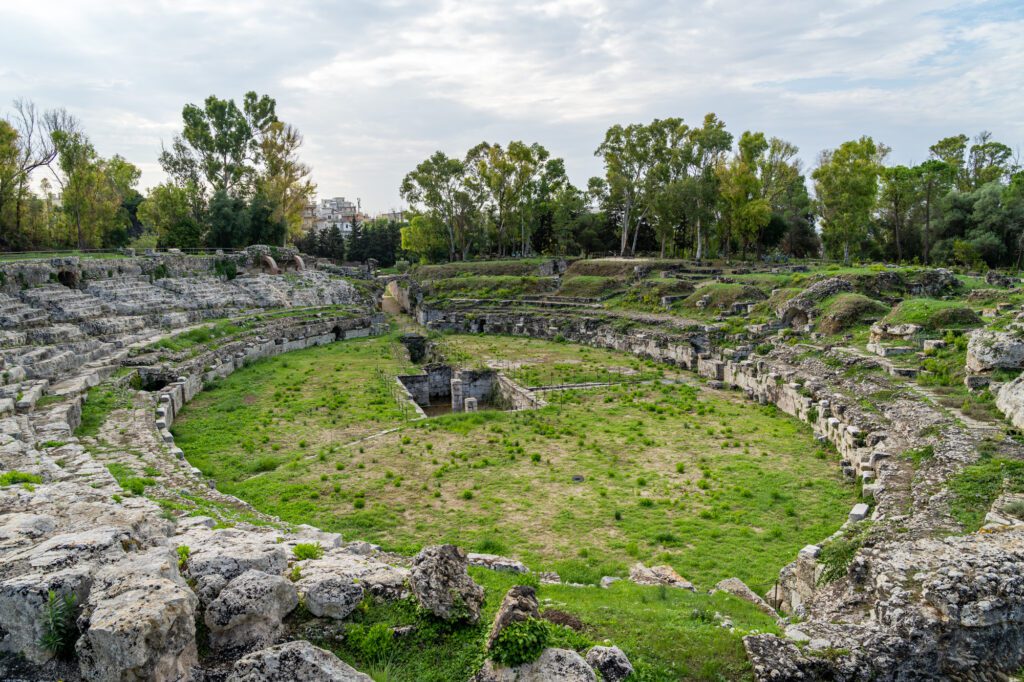
This huge hilltop archaeological park in Siracusa houses the well-preserved ancient ruins of both a Greek theater and a Roman amphitheater.
You can also explore the Latomia del Paradiso, which are ancient quarries that were used to build the city.
Being the most popular tourist attraction in Siracusa, the archeological park can get extremely busy, so try to arrive early (it opens at 8:30am) to avoid the biggest crowds.
The museum, which is a few blocks away and you can buy a combined pass for, was both underwhelming and overwhelming after a few hours of wandering the outdoor ruins, so we’d skip it.
Walk the perimeter of Ortigia

One of our favorite things to do in Ortiga was simply to wander around the perimeter of the island and soak in the historic city and beautiful sea views.
Sunset is the best time to do this walk as you’ll get to experience the sun setting over the water and enjoy the vibrant atmosphere of the city coming alive in the evening.
And if you do it from the northeastern tip to the western end (like this route), you’ll be in a good position to grab a spritz at the end of the walk.
Go underground at Chiesa di San Filippo Apostolo
Head into the crypts of this historic church (which is built on top of a synagogue) in the city’s old Jewish Quarter.
On an underground tour, you can see the tunnel network that was used to shelter civilians during the Allied bombings in WWII.
The short tour is donation based, so you can pay whatever you think it’s worth.
Get Some Sweet Treats at Sabadì Cioccolato
This chocolate shop right near Piazza del Duomo is a great introduction to delicious Modica chocolate – a unique type of chocolate from the Sicilian city of Modica (which you’ll also visit if you continue to follow this itinerary).
The chocolate is cooked slowly at a lower temperature, which means the sugar doesn’t dissolve, and they don’t add cocoa butter, giving it a slightly grainy texture.
Cool Off at Gelateria Gusto
A lovely little gelateria in the heart of Ortigia that served some of the best gelato and granita we had during our time in Sicily.
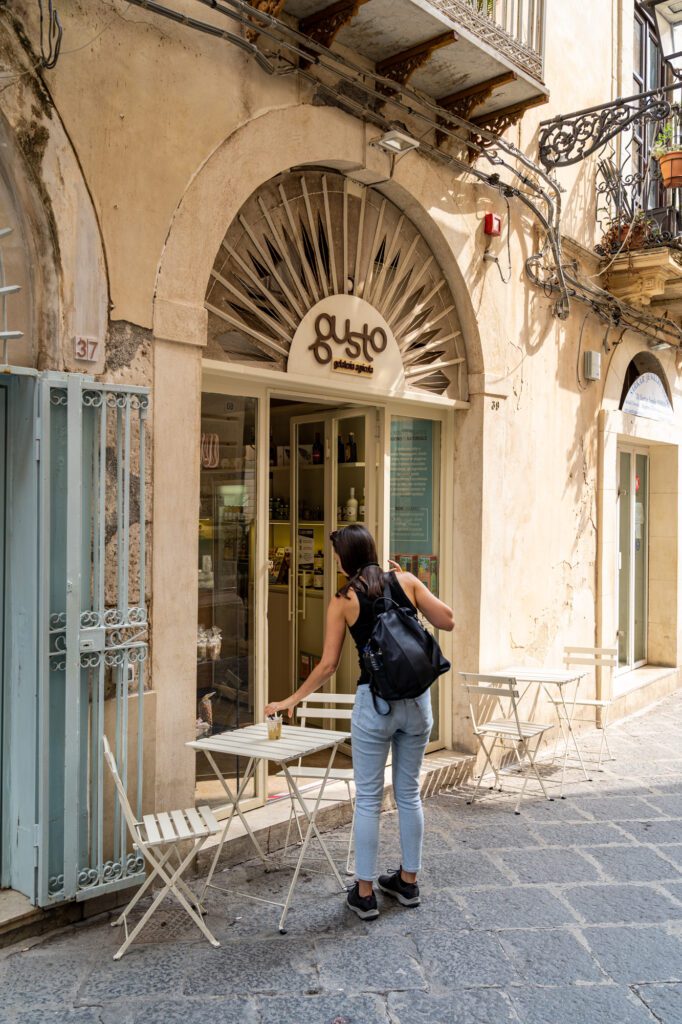
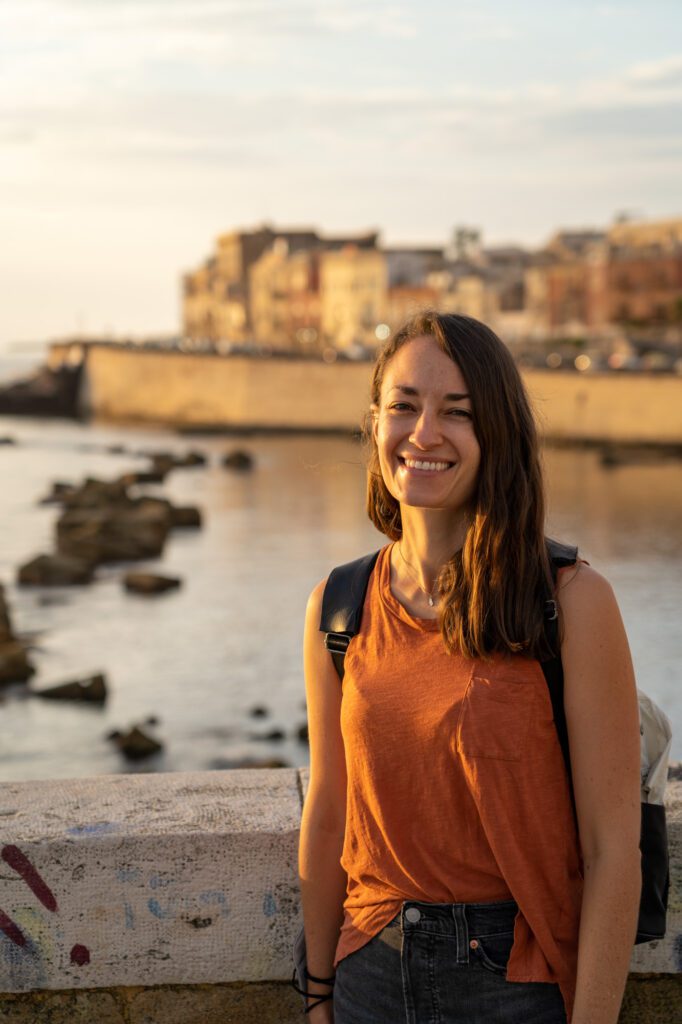
Where to Stay in Siracusa and Ortigia
We’d definitely recommend staying on the island of Ortigia rather than Siracusa. It’s a little more expensive than the mainland, but significantly more atmospheric and charming. You’ll also have more bars, restaurants, and cafes right on your doorstep.
Ortigia is small and compact enough that you can really stay anywhere and be able to walk to wherever you need to go.
We stayed at Stay in Ortigia Guest House, a group of stylish modern apartments inside a historic building in the heart of Ortigia.
Each of the apartments has a fully equipped kitchen and its own seating and dining area, while some also have a private balcony or terrace with city views. There’s also access to laundry.
Some other options for staying in Ortigia:
- Dimore delle Zagare Ortigia – a historic B&B in the charming Jewish Quarter, with cozy double rooms and more spacious studios and apartments.
- La Maison – a charming and elegant B&B with antique gold furnishings, striking chandeliers, and rolltop bathtubs.
- Palazzo Alfeo Aparthotel – spacious apartments with private kitchens and beautiful sea views. One of the apartments even has a jacuzzi on its terrace.
- Calafatari B&B – a sustainable bed and breakfast with sleek, modern rooms, private balconies, and breakfast facilities.
Days 6 & 7: The Val di Noto
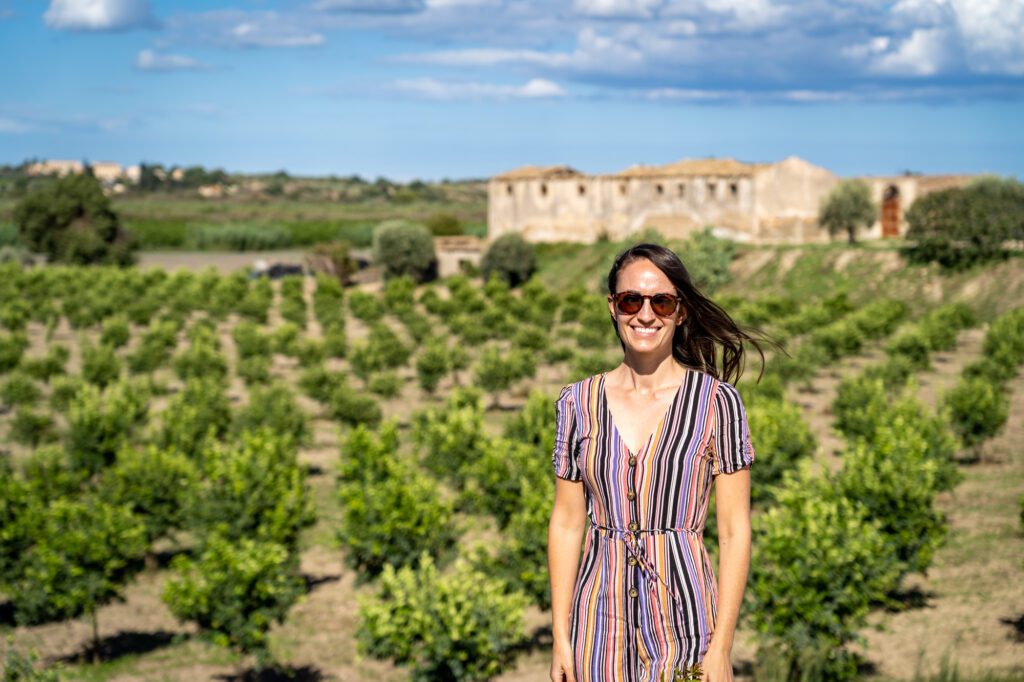
The Val di Noto is a beautiful region of southeastern Sicily that’s famous for its stunning late Baroque style.
So much so that it has been awarded the status of UNESCO World Heritage Site.
The region is made up of eight towns – Caltagirone, Militello in Val di Catania, Catania, Modica, Noto, Palazzolo Acreide, Ragusa, and Scicli – most of which were completely rebuilt after the devastating earthquake in 1693 destroyed much of the area.
There’s so much to see in the Val di Noto that you could easily spend several days here.
But with just one week, we’d suggest dedicating your last 36-48 hours or so to exploring some of the highlights of the region.
Getting To The Val di Noto
This is the only section of this itinerary that we’d recommend getting a car for. You can rent a car in Siracusa and drop it back off on your way up to Catania on the final day.
The drive between Siracusa and the town of Noto takes just 35-40 minutes. Plus, driving in the Val di Noto gives you more flexibility to get to some more rural destinations around Noto (we’ll discuss these more below).
If you don’t want to rent a car, you can still get to both Noto and Modica by train. There’s a regional train line and Interbus route that connect Siracusa to Noto in anywhere between 35-50 minutes. You can then jump back on the regional train at Noto to take a day trip to Modica, which takes around 1 hr 10 minutes.
But if you do decide to travel to the Val di Noto by train, you will miss the beaches of the Vendicari reserve and the waterfront dining in Marzamemi.
Things to Do in The Val di Noto
The best way to spend a couple of days in the Val di Noto will really depend on how you plan to get around. As we mentioned above, some places are more accessible than others without a car.
But there are a few key spots we think you should cover:
- Noto
- Modica
- The Vendicari Reserve
- Marzamemi
If you do have a car, spend your first day exploring Modica in the morning and Noto in the afternoon and evening.
You can drive between the two towns in 40 minutes.
Then spend your second day visiting the beaches of the Vendicari Reserve in the morning and the small fishing town of Marzamemi in the afternoon/evening.
Or if you’re using public transportation to get around the Val di Noto, you can dedicate a whole day to exploring Noto (there’s enough to do), then take a day trip to Modica.
Alternatively, you could organize a private driver or taxi to take you around the Vendicari Reserve and/or Marzamemi for a day.
Explore Noto
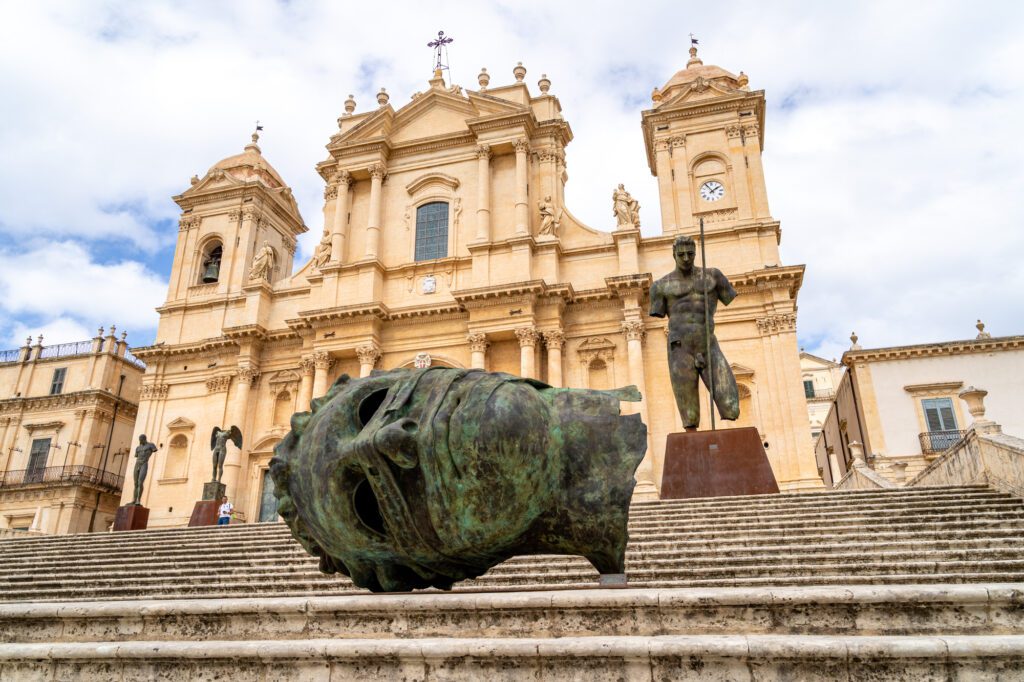
Noto is the crown jewel of the Val di Noto and the most popular tourist destination due to its unique and well-preserved Sicilian Baroque architecture. The elegant town is set on a hillside overlooking the valley to the south.
Some things not to miss in Noto are:
- Caffè Sicilia. This small cafe in Noto is pretty touristy, but it’s famous for its almond granita. Trust us – it lives up to the hype! Check out the “cappuccino,” which is a small scoop of coffee granita on top of a heap of almond granita. They also make great cannoli and lots of other tasty homemade pastries.
- Cattedrale di San Nicolò. The intricate interior of Noto’s grand cathedral is just as impressive as its beautiful Baroque exterior. Don’t miss the amazing stained glass windows underneath the dome, as well as the super realistic paintings depicting the passion of Christ.
- Wander through the city at sunset. The reason we say to be in Noto during the afternoon and evening is that admiring the Baroque sandstone buildings glow orange and red as the sun sets over the city is an absolute must! This loop will take you to some of our favorite viewpoints in town.
Explore Modica
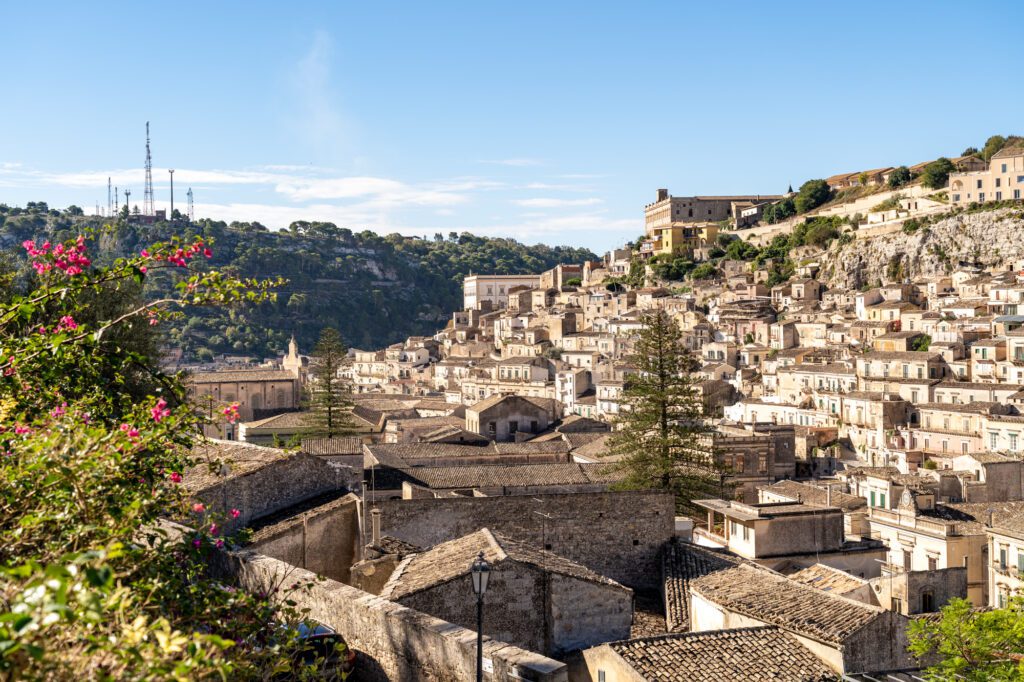
Modica is another lovely Baroque town in the Val di Noto that stands out from its neighbors thanks to its unique stoneground chocolate.
Modica chocolate is a locally produced delicacy that’s made using only cocoa mass and cane sugar (no cocoa butter) and cooked at low temperatures, producing a slightly grainy texture that’s similar to traditional Aztec chocolate.
The cacao is often mixed with local Sicilian flavors, such as citrus fruits, almonds, pistachios, and hazelnuts, to create a delicious and indulgent treat.
The best things to do on a visit to Modica are:
- Cioccolato di Modica Quetzal. This unique chocolate shop is not only the best place in town to try high-quality artisanal Modica chocolate, but you can also learn about the production process and other cultural activities organized by Modica’s Quetzal Cooperative.
- Hike up to this viewpoint. It’s quite the walk, but the views over the town and surrounding region are more than worth it. You’ll pass by Duomo di San Giorgio and Castello dei Conti on the way up too.
- Casa del Formaggio Modic. The owner Giorgio is the friendliest cheesemonger we’ve ever met. We still talk about our experience here – “hey, remember the friendliest cheese man ever in Modica?”
- Cafe Adamo. For the best gelato in town. They have lots of delicious cakes and pastries too.
Day Trip to the Vendicari Reserve & Marzamemi
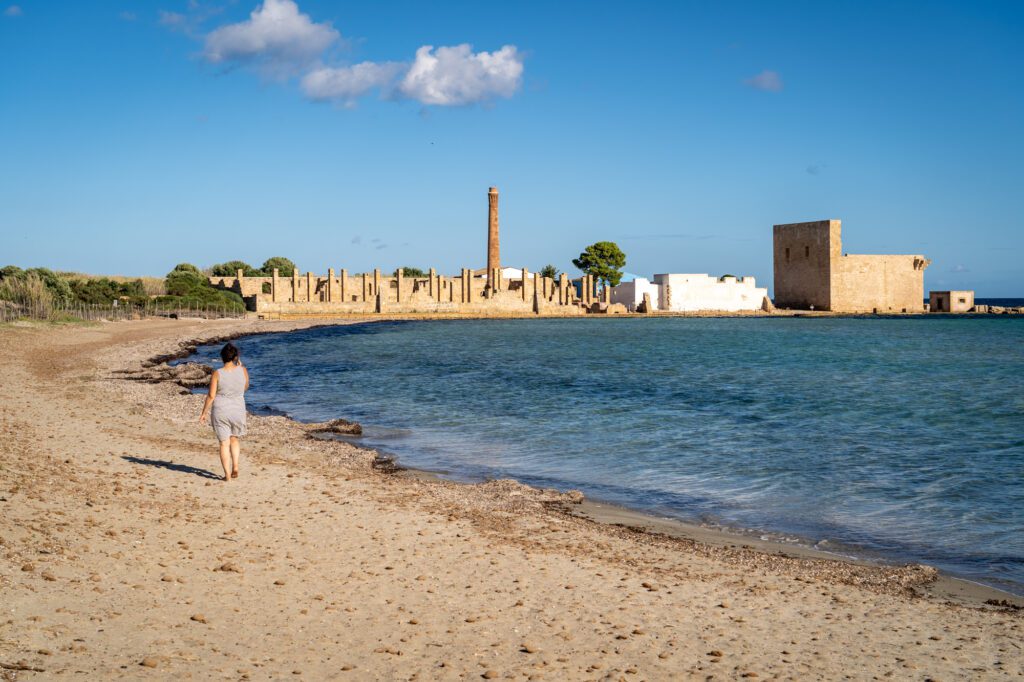
The first thing to note is that you will need a car for this day trip from Noto. Or you could always organize a private driver or taxi to take you around for the day.
The Vendicari Reserve was highly recommended to us from the hosts at our little B&B in the countryside, and we’re glad that we ended up taking their advice.
There are three main beaches in the reserve: Spiaggia di Vendicari, Spiaggia di Calamosche (the prettiest and busiest), and Spiaggia di Marianelli (a nudist beach).
Head to the main entrance and park your car here. At the time of our visit, it cost 3 Euros to park for the day (which is reasonable for this area).
You can then take a lovely walk along the reserve to discover the different beaches. It costs 3.50 Euros per person to enter the reserve (on top of the parking fee), so make sure to bring enough cash with you.
Once you’ve finished at the beaches, drive around 20 minutes to the south and spend the late afternoon and evening soaking up the waterfront ambiance in Marzamemi, a small former fishing village on the sea.
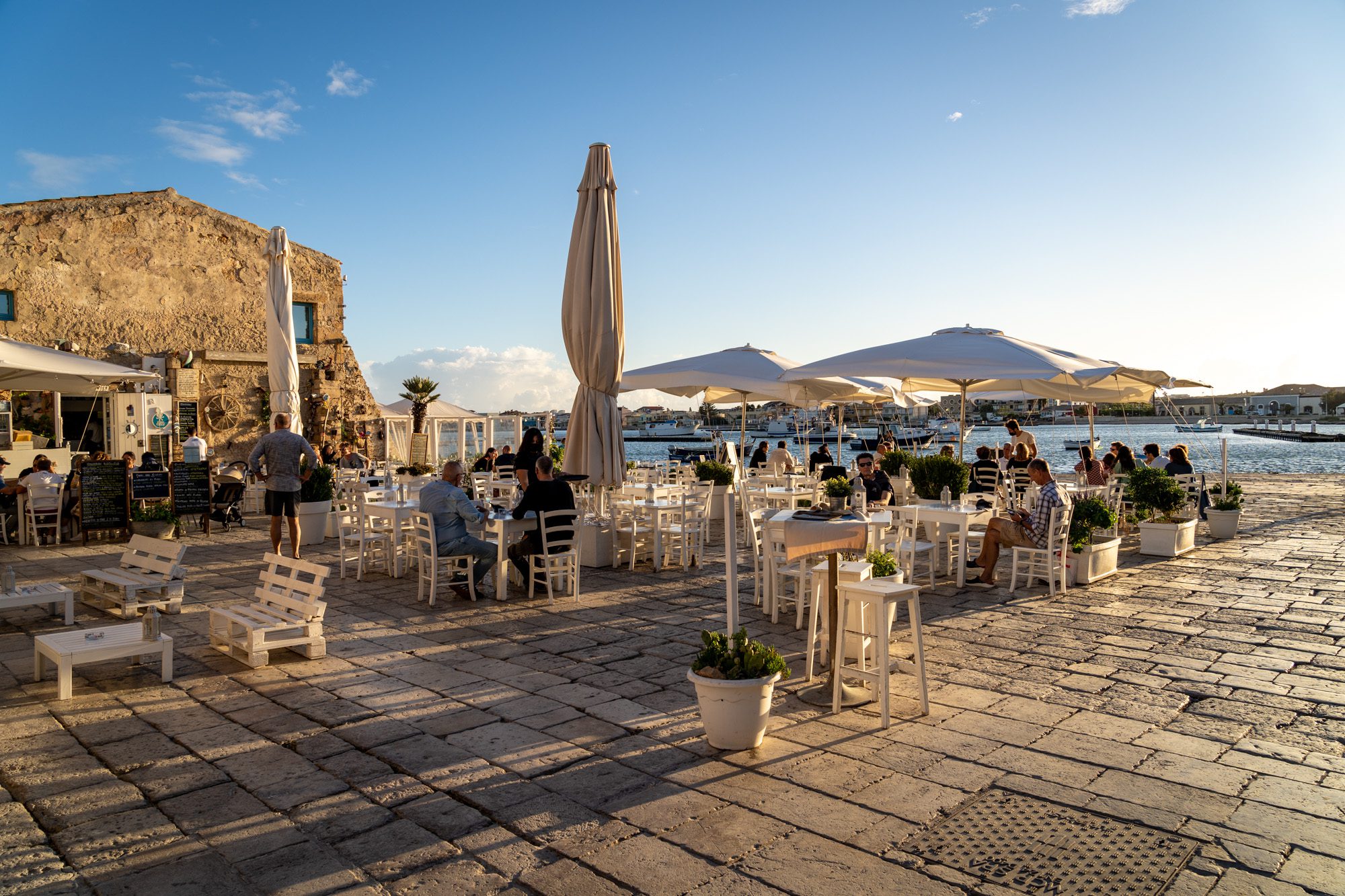
Where to Stay in The Val di Noto
You basically have two options here – stay in Noto, which is more convenient for the train and walking around the city, or stay outside of Noto in the countryside, which is more rustic and charming.
We chose to stay in one of the agroturismos just outside of the city, and absolutely loved our couple of nights at Fiori di Noto.
There was no Wifi. But who needs it when you’re lounging in the Sicilian sun under orange and olive trees with kittens running around the property? It’s super rustic and charming, and we loved it.
Other options for staying in Noto:
- Embrace Sicily Guest House – a modern guest house in the heart of Noto with friendly hosts and an excellent breakfast buffet. The superior room even has a private jacuzzi.
- A Calata – a sustainable bed and breakfast with a communal living space and fully-stocked kitchenette for guests to use.
- Welcome Garden Noto – a charming, traditional guest house with exposed brick walls, wooden beamed ceilings, and a large central courtyard.
Other options for staying outside of Noto:
- IUTA Glamping & Farm – a beautiful glamping site with luxurious private lodges, an outdoor swimming pool, and beautiful surrounding gardens just a 10 minute drive from Noto.
- Relais Terre di Romanello – a sustainable farm stay with elegant and spacious rooms, a large shared pool, and a beautiful terrace to enjoy an al fresco breakfast each morning.
- Valle Degli Dei AgriResort – a traditional farm stay in the peaceful Val di Noto countryside, featuring spacious private apartments with their own living space, kitchen, and outdoor dining area.
